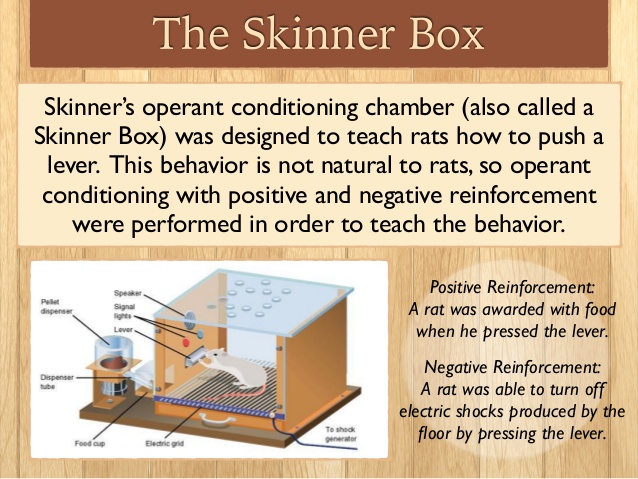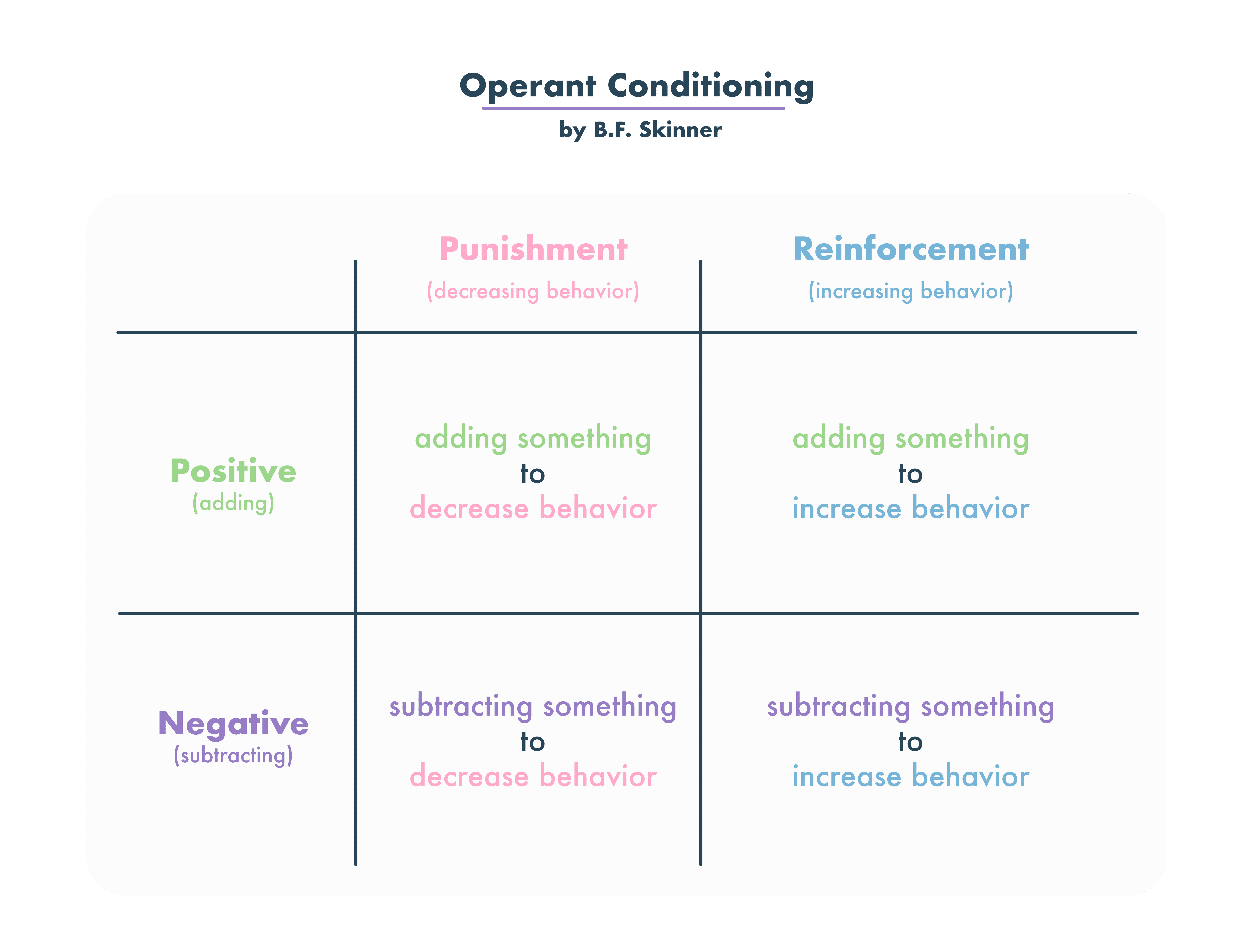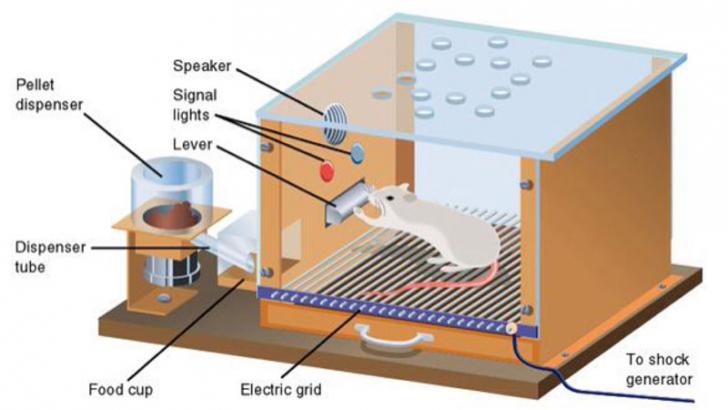7 Skinner Used the Term Operant Conditioning to Describe
Rats pressing a lever to receive food until they were full. The term operant conditioning 1 was coined by B.

Skinner Operant Conditioning M Ed Visual Art Education
He used a special box known as Skinner Box for his experiment on rats.
:max_bytes(150000):strip_icc()/2794863-operant-conditioning-a21-5b242abe8e1b6e0036fafff6.png)
. Interventions for those who display self-injury. It is the form of conditioning which explains the relationship between behavior and their consequences or rewards Reinforcements and Punishments. Conditioned reflexes exhibited by dogs.
To put it in more general terms Skinners theory dealt with the. - 1905- used animals in a puzzle box to propose the theory known as the law effect this was used as the basis of BF. Skinner who used reinforcement to train pigeons to walk in a figure eight and play ping pong as a way to prove that rewarded behavior will reoccur.
Skinner in 1937 in the context of reflex physiology to differentiate what he was interested inbehavior that affects the environmentfrom the reflex-related subject matter of the Pavlovians. Focus your search terms on Skinners views of human behavior. Operant Conditioning It is a type of learning that involves an increase in the probability that a response will occur as a function of reinforcement.
Skinner in his theory of operant. A conditioned reflexes exhibited by dogs b rats pressing a lever to receive food until they were full c interventions for those who display self-injury d all the techniques used in ABA. Skinner believed classical conditioning was too simplistic to adequately account for complex human behavior.
Skinner used the term operant conditioning to describe. All the techniques used in Applied Behavior Analysis. Skinner used the term operant conditioning to describe.
Up to 24 cash back Skinner 1948 studied operant conditioning by conducting experiments using animals which he placed in a Skinner Box which was similar to Thorndikes puzzle box. Skinner proposed his theory on operant conditioning by conducting various experiments on animals. Operant conditioning was first described by American psychologist and behaviorist B.
Skinner used the term Operant as a reference to any active behavior that operates upon the environment to generate consequences 1953. In this form of conditioning operant response with stimuli is allowed to occur and is followed by a reinforcing stimulus for which there is a increased likelihood that the operant will occur again. Skinner and also known as an operant conditioning chamber this box also has a device that records each response provided by the animal as well as the unique schedule of reinforcement that the animal was assigned.
Skinner has defined Learning behavior through a called an operant conditioning theory. Common animal subjects include rats and pigeons. October 7 2021.
Actions followed by good outcomes are likely to recur and actions followed by badshow more content It is a set of therapies and techniques based. According to an article written there are four types of operant conditioning. Chapter 7 Written Responses.
A box that that presented a puzzle to an animal and reinforced punished or neutrally rewarded specific behaviors and studied the outcomes. Operant conditioning is a method that strengthens or diminishes behaviors using some sort of reinforcer or punisher. It was developed by the famous behaviorist BF.
As the first step to his experiment he placed a hungry rat inside the Skinner box. Each of the following is an important component of a neuron or of the connection between neurons. His insistence to study the external causes and consequences of human behavior gave birth to the new theory of Operant Conditioning Learning.
Christina Hubbard Unit 1 DB July 29 2010 American Intercontinental University BF. Skinner used the term operant conditioning to describe the effects of consequences of a particular behavior on the future occurrence of that behavior. Developed by B.
Positive reinforcement strengthens a response by presenting something that is typically pleasant after the response whereas negative reinforcement strengthens a response by reducing or removing something that is typically unpleasant. Skinner explain language development in terms of operant conditioning. The term was novel but its referent was not entirely new.
Skinner is regarded as the father of Operant Conditioning but his work was based on. Operant Conditioning Learning. Skinner 1953 stated that all we need to know in order to describe and explain behavior is this.
Skinner believed that Pavlovs conditioning which involves physiological b _____ was not very useful in understanding other forms of ongoing behaviors. It means roughly changing of behavior by the use of reinforcement which is given after the desired response. Positive reinforcement is a term described by B.
Skinner used the term operant a _____ to describe something that can be modified by its consequences. Skinner expanded on Thorndikes ideas to develop a set of principles to explain operant conditioning. What Is Operant Conditioning and How Does It Work.
The Skinner Box Operant Conditioning Skinner Box Constructivist Learning Theory When operant behavior that has been previously reinforced no longer produces reinforcing consequences the behavior gradually stops occurring. Operant responses provide one way to separate ongoing behaviors into units that can be observed and measured. Describe the controversy over Skinners views of human behavior and identify some ways to apply operant conditioning principles at school at work and at home.
Instead he suggested the best way to explain and predict behavior was to analyze the external causes of an action and its. What were Noam Chomskys criticisms of Skinners account. According to him The behavior of an individual is influenced by the consequences.
Skinner 1938 coined the term operant conditioning.
:max_bytes(150000):strip_icc()/2794863-operant-conditioning-a21-5b242abe8e1b6e0036fafff6.png)
What Did You Learn About Skinner Operant Conditioning Quora

Operant Conditioning Examples And Research Practical Psychology

Comments
Post a Comment